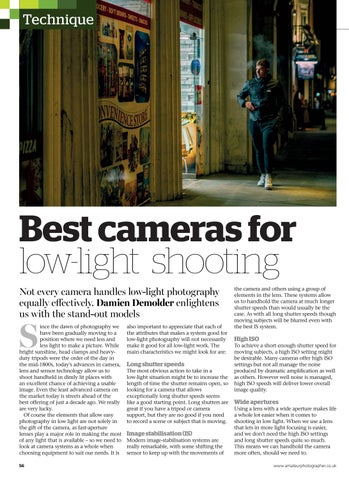Technique
Best cameras for low-light shooting The sensor’s impressive dynamic range can be clearly seen in this Rutland Water sunset
Not every camera handles low-light photography equally effectively. Damien Demolder enlightens us with the stand-out models
S
ince the dawn of photography we have been gradually moving to a position where we need less and less light to make a picture. While bright sunshine, head clamps and heavyduty tripods were the order of the day in the mid-1800s, today’s advances in camera, lens and sensor technology allow us to shoot handheld in dimly lit places with an excellent chance of achieving a usable image. Even the least advanced camera on the market today is streets ahead of the best offering of just a decade ago. We really are very lucky. Of course the elements that allow easy photography in low light are not solely in the gift of the camera, as fast-aperture lenses play a major role in making the most of any light that is available – so we need to look at camera systems as a whole when choosing equipment to suit our needs. It is
also important to appreciate that each of the attributes that makes a system good for low-light photography will not necessarily make it good for all low-light work. The main characteristics we might look for are:
Long shutter speeds
The most obvious action to take in a low-light situation might be to increase the length of time the shutter remains open, so looking for a camera that allows exceptionally long shutter speeds seems like a good starting point. Long shutters are great if you have a tripod or camera support, but they are no good if you need to record a scene or subject that is moving.
Image stabilisation (IS)
Modern image-stabilisation systems are really remarkable, with some shifting the sensor to keep up with the movements of
the camera and others using a group of elements in the lens. These systems allow us to handhold the camera at much longer shutter speeds than would usually be the case. As with all long shutter speeds though moving subjects will be blurred even with the best IS system.
High ISO
To achieve a short enough shutter speed for moving subjects, a high ISO setting might be desirable. Many cameras offer high ISO settings but not all manage the noise produced by dramatic amplification as well as others. However well noise is managed, high ISO speeds will deliver lower overall image quality.
Wide apertures
Using a lens with a wide aperture makes life a whole lot easier when it comes to shooting in low light. When we use a lens that lets in more light focusing is easier, and we don’t need the high ISO settings and long shutter speeds quite so much. This means we can handhold the camera more often, should we need to.
56 www.amateurphotographer.co.uk
56-61 LowLightCameras Feb15 GH JP.indd 56
07/02/2022 14:17











